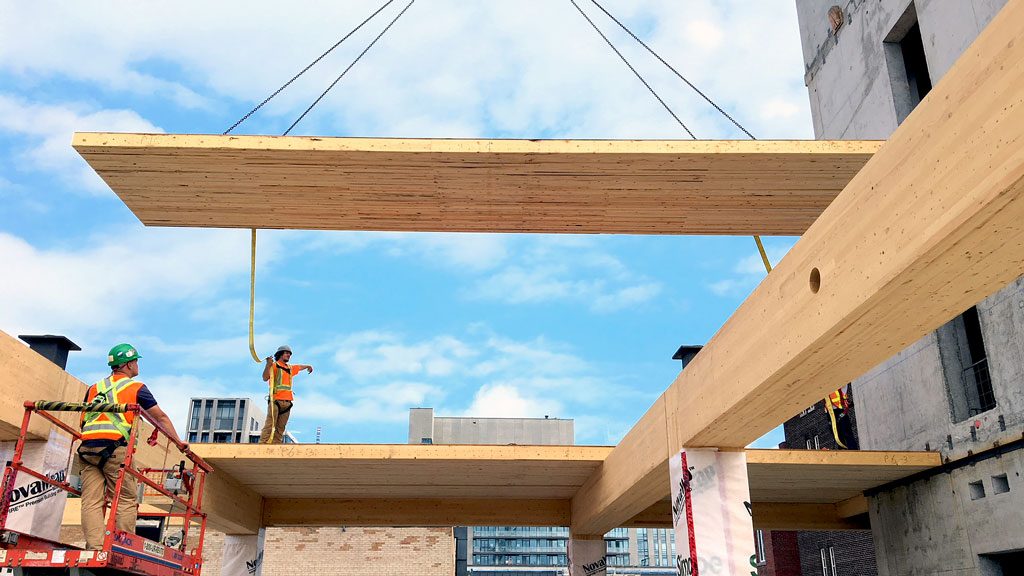With several installations under its belt, Timmerman Timberworks Inc. has opted to automate fabrication of nail-laminated timber (NLT) panels.
The firm, based in New Lowell, Ont., near Barrie, is reportedly the only company in Canada to have done so.
It is currently installing panels at 80 Atlantic Ave. in Toronto, the first new timber-frame commercial building to be constructed in the city in a generation.
“Fabricating NLT panels by hand is quite labour-intensive,” says Timmerman president Michael Krans, who co-founded the company in 1999 with his brother Henry.
“And much of the work is repetitive, so automating the process makes sense from a cost-of-labour perspective.
“Knowing that we had 80 Atlantic to build and other projects in the pipeline, we felt we had enough work for the machine to justify the significant cost.”
The machine, housed at Timmerman’s 20,000-square-foot plant at 2 Greengage Rd., nails the laminations into place at a rate of 12 nails per second.
An entire panel can be fabricated in as little as 45 minutes. Timmerman can manufacture as many as eight NLT panels per day in dimensions of up to 10-feet by 50-feet.
An estimated 200 NLT panels will be installed at 80 Atlantic. Installation is expected to be completed by early December.
Krans said the other significant factor in the company’s decision to automate the fabrication process was a desire to improve the quality of the panels.
“Nailing up solid ‘rafts’ of dimensional lumber sounds like a fairly simple process,” he said. “But when you add variations in the lumber, different nailing patterns, different lay-up patterns and the importance of coming up with consistent rectilinear shapes, then it soon becomes clear that an automated process is the best way to control all of these variables.”
Krans said while most people think the nailing system is the most impressive part of the machine, “it’s really the clamping process that makes it all work.”
Timmerman’s first project incorporating NLT was a barn floor, “completed ages ago, and built the old-fashioned way — in place and by hand.”
The firm recently completed installation of a retrofit, panelized NLT floor for the new Soma Chocolate plant in Toronto. It is currently working on another retrofit project, a floor for a barn in Caledon that is used as a wedding facility.
“After that, we will be working on the full roof system for a new hospice in Vaughan.”
While not yet in widespread use in Canada, Krans said NLT is in fact growing in popularity. He noted the product has been installed more often on the West Coast than in Ontario.
Asked whether his firm is ramping up for increased use, Krans said the decision to mechanize the fabrication process was based on the assumption that the volume of work would make it a worthwhile investment.
“So, on the one hand you could say that we have already ramped up for the market, but on the other hand, we have the capacity right now to put out even more material,” he said.
“If things do get even busier, however, we have already identified our next steps to boost production. We would put the money into a bit more infrastructure to make it happen.”
Krans said he believes the release last year of a NLT Canadian design and construction guide will help pave the way for more such projects in this country.
“The technical detailing will vary from project to project, but having the guide gives architects and engineers a good design baseline and the confidence to specify the material,” he explained.
The guide was co-edited by architecture and design firm Perkins+Will and structural engineering firm Fast + Epp, the same team that produced a similar guide for the U.S. building industry.
Krans, whose firm also fabricates cross-laminated timber (CLT) and other heavy timber components, said the wood construction market has really grown over the past three to four years on the commercial side.
“We credit this to the growing popularity of new types of mass timber, specifically CLT and NLT,” he said. “But it is also due to the fact that people are starting to realize that building with mass timber makes sense.
“It’s fast, green, esthetically pleasing and economically competitive. We still face challenges, particularly with regard to convincing people of the inherent fire resistance of heavy timber members, but there is no denying the momentum in the market.”




Recent Comments